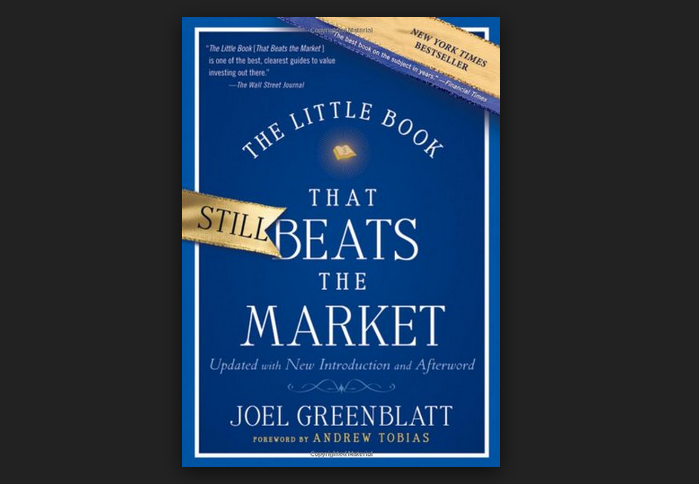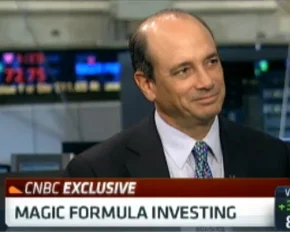The Little Book That Beats the Market: Review, Quotes, & Lessons Learned
Photo: Amazon
We wanted to share with you a simple but important book: The Little Book That Beats The Market, by Joel Greenblatt. If you have read this book and already adhere to its principles, then you probably have a second house and can use a second copy. Or, alternatively, you might consider sharing it with friends or family members as it summarizes certain investment principles that will serve them well over their investing lifetimes.
The Magic Formula: ROIC & Earnings Yield
In his book, Greenblatt presents a “Magic Formula” for buying good companies at good prices. These concepts – good company and good price – are represented by two ratios from companies’ financial statements:
Return on Invested Capital (ROIC) represents “good company”
& Earnings Yield represents “good price".
Here is the technical definition of both ratios, plus a quick way to think about them:
Return on Invested Capital (ROIC) = Earnings Before Interest & Taxes / (Net Working Capital + Net Fixed Assets)
This tells you how much cash a company generates in relation to the amount of capital tied up in its business. As ROIC numbers increase, all else being equal, a business gets better and better. The reason is that when you own a business, the higher your ROIC, the more money you are able to pocket every year in relation to the money you have invested in the business.
Earnings Yield = Earnings Before Interest & Taxes / Enterprise Value (Market Value + Debt – Cash)
This tells you how expensive a company is in relation to the earnings the company generates. When looking at Earnings Yield, we make certain adjustments to a company’s market capitalization to estimate what it would take to buy the entire company. This involves penalizing companies that have a lot of debt and rewarding others that have a lot of cash.
Greenblatt’s Magic Formula gives these two ratios equal weight when selecting investments. The Formula ranks all companies in the investable universe by Good Company (ROIC) and also by Good Price (Earnings Yield). Then, each company’s ROIC and Earnings Yield ranks are added together. Greenblatt’s Formula has an investor buy companies with the best combined rankings, hold each company for a year, and then move funds into new highly ranked companies. This approach is sound and simple enough that when someone wants to learn about investing or is considering managing his own equity portfolio, we strongly encourage him to read Greenblatt’s book.
If you have not read this book, please do take the 90 minutes needed to digest it and then ponder the questions and observations below.
Questions To Ponder
1) Isn’t it amazing that by unemotionally buying stocks of good companies (as measured by high prior year returns on capital) at low prices (as measured by a low enterprise value in relation to a company’s prior year operating income), that you can be a better than average investor over long periods of time?
"To earn a high return on capital even for one year, it's likely that, at least temporarily, there's something special about that company's business. Otherwise, competition would already have driven down returns on capital to lower levels." {page 82}
"Warren Buffett.. said buying a business at a bargain price is great. However, buying a good business at a bargain price is even better." {Afterword to 2010 Edition}
2) What does this say about the value added by the collection of fund managers, brokers, financial news sources, and investment analysts who make big money trying to anticipate the markets and select individual securities?
"Many managers feel the only way to avoid that risk is to invest pretty much the way everyone else does. Often this means owning the most popular companies, usually the ones whose prospects look most promising over the next few quarters or the next year or two." {page 74}
3) Given that few people adhere to this type of simple but fruitful approach, what does this tell us about human emotions (fear/greed) and biases (over confidence, recency bias, seeking the comfort of the herd and the comfort of ‘expert’ opinions)?
"Stock prices move around wildly over very short periods of time. This does not mean that the values of the underlying companies have changed very much during that time period.. the stock market acts very much like a crazy guy named Mr. Market." {page 35}
"..it is Mr. Market's constantly changing emotional state that creates the bargain opportunities." {page 94}
Opportunities To Do More
At Euclidean, we do not believe sound investing needs to be complex. Rather, we believe sound investing requires only disciplined adherence to sound principles over long periods of time. We think Greenblatt’s ‘magic formula’ satisfies this requirement. We also believe, however, there are many opportunities to go beyond Greenblatt’s approach. A few of these opportunities can be envisioned by the following thought experiments.
1) Consider how you might evaluate the character of a business. What risks would there be to looking only at a company’s prior year results? What could be gained by looking a company’s historical financials -- its ‘body of work’ -- over many years?
2) Consider if a business might have other qualities that might impact the price at which it becomes a good value. Do you think a company that is growing should be valued the same way as a company that is shrinking? Should you pay more for a company that pays dividends than for a company that retains all earnings? Would a company ever have balance sheet risks that might cause you to avoid its shares even if it passed Greenblatt’s magic formula?
In the past, we have conducted a study and simulation using our technology that examines Greenblatt's "Magic Formula" in greater depth. The results were very interesting, both regarding the formula itself and how strategies that focus on buying companies when they are "on sale" - something that Euclidean and the Magic Formula have in common - might perform during pessimistic periods when the average company's valuation contracts as a multiple of earnings.
Make sure to check out our simulation's results and get in touch with us if you have any questions. As Euclidean’s mission has been to find and deploy the best systematic method for long-term equity investing, we have devoted our energies to exploring these and many other important questions. We are unemotionally applying the best answers we have been able to derive as we work to grow our investors' hard-earned money over long-periods of time.
Best Regards,
John & Mike
Additional resources on
The Little Book That Beats the Market
Purchase The Little Book That Still Beats the Market (new edition)
Book website - MagicFormulaInvesting.com


